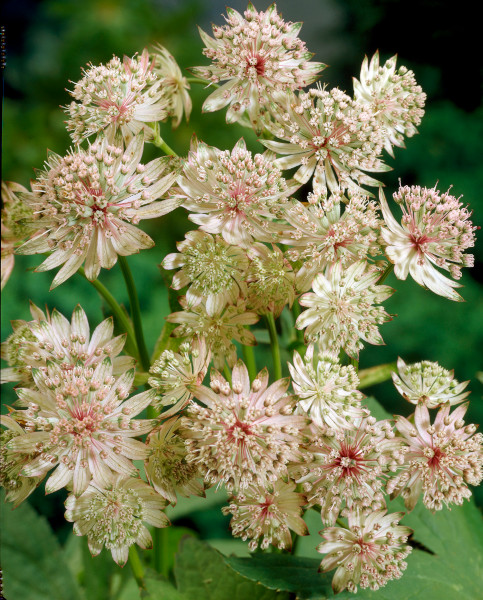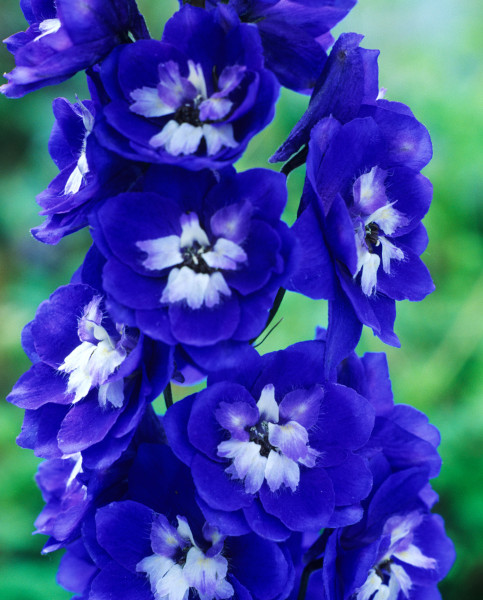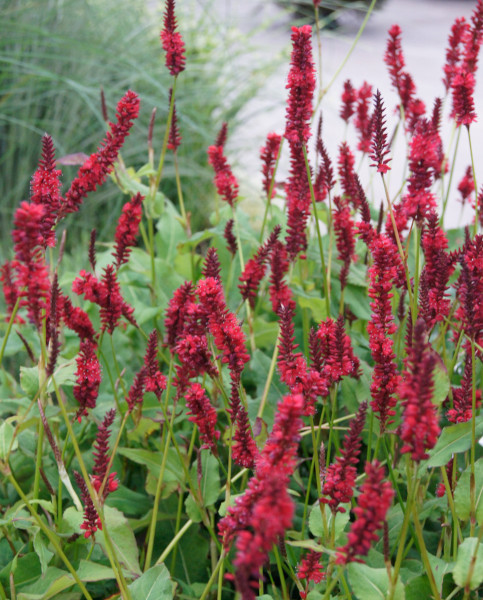How to grow Astrantia
This member of the umbel family contains 10 species of clump-forming herbaceous perennials, found growing in woods and meadows from Europe to western Asia. It is cultivated for its long-lasting profusion of pincushion-like flowers, and ability to thrive with the minimum of fuss. Astrantia is often one of the first of the summer perennials to come into flower, and can quite often be seen blooming in May. Much loved by bees and other pollinators for their nectar-rich blooms, the stems also make a long lasting addition to indoor floral arrangements.
Astrantia are also known by the common names Hattie’s pincushion and masterwort.

Key Information
Soil pH
Position
Hardiness


Where & when to plant Astrantia
All types of Astrantia love to be planted in sun or dappled shade, in soil which is fertile and rich in organic matter. The planting area should be on well-drained ground which ideally stays moist, although once established, Astrantias can cope with drier conditions.
Plant your young Astrantia in Spring or Autumn which will allow the plants to put down roots whilst the soil is warm. If you have purchased plants in winter, it would be wise to leave the plants in their containers in a sheltered location until the weather warms up before planting out. For summer planting, extra care should be taken to ensure young plants are well watered and do not dry out.
How to plant Astrantia
In the ground
- Clear the chosen area of weeds.
- Dig a planting hole several times larger than the root ball. Now is the time to give your soil a boost by adding well-rotted organic matter to the planting hole and mixing thoroughly. If your soil is heavy clay, add a generous amount of horticultural grit as well.
- Place the plant in the hole, ensuring the top of the root ball sits level with the surface of the soil. Too low and the plant may rot, too high and the roots can dry out.
- Backfill with soil and firm in gently.
- Soak well with water.
- Mulch around the base with well-rotted organic matter.
In a container
- Choose an appropriate container, ensuring there are plenty of drainage holes.
- It can be worth potting up large containers in situ to save yourself the trouble of moving once full.
- Use a good quality potting compost with plenty of horticultural grit mixed in, and, if not already present in the compost (check the description on the bag) some slow-release plant food.
- Start by partially filling the pot with compost; enough so that when placed on it the upper surface of the root ball is about 3cm lower than the top of the pot.
- Infill all the space surrounding the root ball with compost, firming down with your fingers then adding a little more so the plant is held tight.
- Pick up the pot (if you can!) and lightly tap on the potting bench or ground a few times to help further settle the compost around the plant.
- Soak well with water.
- A mulch with horticultural grit will look attractive and help to prevent a ‘cap’ or crust forming on the top of the compost (something container plants can suffer due to the artificial nature of their watering).

What to plant with Astrantia
Reliable, long flowering, and resistant to pests like slugs and snails, Astrantia are a much-loved garden gem and make a great addition to cottage gardens as well as modern planting schemes. The papery blooms sparkle in dappled shade and are loved by bees and other pollinators.
Mix into the border, or plant under a tree or along a pathway with lush plants such as Hostas, Ferns, Heuchera, and Tiarellas, perhaps adding in other airy plants like Lysimachia, Persicaria, Astilbe, and Thalictrum for a fully and natural look in part-shade. These plants will all thrive in similar conditions to Astrantia.
Plant amongst Roses, Salvias, Aquilegias, Anthriscus, Poppies, Delphiniums, and Iris for a more traditional look, full of colour and texture.
Please contact our expert and friendly Customer Care Team at Hayloft if you would like any further growing guidance or planting suggestions for your Astrantia major - we will be more than happy to help.



How to care for Astrantia
Pruning and Deadheading
Cut the whole thing back by half after the first main flush of flowering to promote further blooms. Flowers can be deadheaded individually, though their abundant nature can make this prohibitively time-consuming!
Cut back to ground level in autumn or early spring.
Watering
Water until established (this usually means throughout the first growing season), and then in very dry spells thereafter.
Container-grown astrantia should be watered regularly throughout the growing season. Allow the top few centimetres of compost to dry out between soakings.
Cold Protection
Astrantia is fully hardy and able to withstand a UK winter without the need for additional protection.
Pests and Diseases
Astrantia tends to be problem-free aside from the potential for powdery mildew (a fungal disease). This appears as a white, powder-like coating on foliage, and can be caused by poor air flow, drought stress, or insufficient sunlight.
Prune off and dispose of any affected leaves, keep plants well-watered (avoiding water on the foliage if possible), and if necessary, thin out surrounding plants to improve airflow. Do not over fertilise, as this will generate an excess of soft, new growth which is particularly susceptible.
How to propagate Astrantia Major
Astrantia can be propagated by the division of established clumps in spring or autumn (every three or so years). As well as providing new plants, this also maintains the health and vigour of existing clumps.
- Choose a day when the soil is not frozen or waterlogged.
- Dig the plant out of the ground.
- Shake off any excess soil.
- Separate the plant into sections using either swift, cutting blows with a sharp spade, or two forks inserted back-to-back with tines touching, handles then pushed together to prise the plant apart.
- Discard old, damaged, or surplus pieces, keeping healthy, vigorous material.
- Replant selected pieces where desired.
- Water well until fully established.
Common Astantia questions
- Is astrantia easy to grow?
Astrantia is one of the most reliable and fuss-free plants available to grow. It is an ideal choice for children, beginners, or time-poor gardeners. - Should I cut back astrantia?
Yes, astrantia should be cut down to the ground in either autumn or early spring. It can also be lightly chopped midseason to promote a second flush of flowers. See our ‘Pruning and deadheading’ section about for more information. - Can I split astrantia?
Indeed you can! This is a great way to create more plants as well as breathing new life into existing clumps. See our ‘How to propagate astrantia’ section above. - Is astrantia poisonous to dogs?
Astrantia has no known toxic effects to animals or people.
- Does astrantia self-seed?
It sure does. Astrantia is fairly prolific in this department, though the offspring can often be a less impressive cross of two cultivars.




